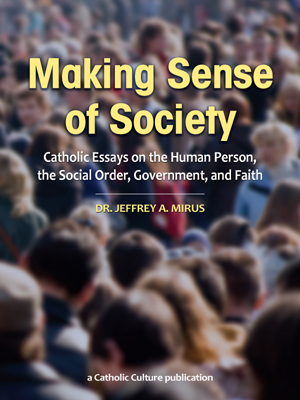The Mystery of Music, Part I
By Thomas V. Mirus ( bio - articles - email ) | Sep 12, 2014 | In Reviews
Music expresses that which cannot be said and on which it is impossible to be silent. —Victor Hugo
The unique power of music to move the human heart is universally acknowledged. Music is often given a special place among the arts, as in Walter Pater’s claim that “all art constantly aspires towards the condition of music.” It is also, with architecture and design, the ubiquitous art form in modern society.
Music accompanies us everywhere, and this observation is almost identical with the observation that music is, in practice, given less attention and respect than any other art. Most people are accustomed to sitting in a dark room and devoting their full attention to a film, yet it hardly occurs to them that music has any other purpose than to serve as pleasant or stimulating background noise. Indeed, music lends itself to this use because of its relatively transitory and “immaterial” nature, appealing to only one of the senses.
This is not merely a matter of “cultured” vs. “non-cultured” people. It can be just as difficult to get an intellectual, or the reader of the densest novels, to sit in exterior and interior silence and simply listen to a piece of music. This is because music is also the least conceptually bound of all the arts, and constant discursive thought can be as much of an obstacle to contemplation as a short attention span. It seems that attentive listening to music, like prayer, is something for which no one seems able or willing to find time.
Music is also perhaps the least understood art. Even genuine music lovers or critics often have great difficulty explaining what it is that they love about a particular piece of music, beyond describing a subjective emotional response. This makes disputes over musical taste all the more fierce, as the nineteenth-century French novelist Stendhal noted: “Our inability to account for the why of our musical appreciations turns the wisest man into a musical fanatic.”
The philosophers have not fared much better in understanding music, for which there are three outstanding reasons. First is that the subject of beauty itself has been given little attention in comparison with such subjects as being, truth, and goodness. “Beauty is the poor relation of the transcendental family,” Étienne Gilson observed, and insofar as philosophers have written about beauty, it is “the idea of the beautiful” that has been the object of their speculations rather than the “concrete, sensible things” in which artistic beauty is found.
This leads into the second reason music has eluded the philosophers: above all the other arts, it cannot be translated in terms of concepts, and philosophy is a decidedly conceptual enterprise. Particularly in the ancient and medieval world, philosophers and theologians tended to write about the “music of the spheres,” theories of acoustics, and music as an expression of mathematics. However fruitful their investigations in these areas, they were not focused on the art of music per se.
The third reason is historical: it is only over the last two centuries or so that music (that is, pure or instrumental music) has been emancipated as an independent art form. For example, when Plato wrote of music imitating the passions, his definition of music (mousike) included words, and was deeply tied to dramatic performance. Even as instrumental music became more prominent, it was often viewed as superficial or decorative. In his Critique of the Power of Judgment, Immanuel Kant distinguished between “free beauty,” which is “self-subsisting” and requires no reference to something outside itself, and “adherent beauty,” which is connected to a concept. He placed music without a text under free beauty. By implication, the beauty of instrumental music is the purest sort, but ironically, this led Kant to count it as the lowest of the arts, equivalent to wallpaper design, because it “merely plays in sensations” rather than representing an idea subject to conceptual aesthetic judgment, which for him was the higher function of art.
If it is true that an art that does not address reason can appeal only to the senses, Kant was right to say that instrumental music is “more pleasure than culture.” But there is more to the intellect than reason; indeed, reason is preceded by intuition. If we wish to understand art in a rationalistic age, we must locate and reclaim the human heart as that to which all art, and music especially, addresses itself. It is then that the true depth and significance of music will be revealed to us.
Ultimately the only way to understand music is to spend a great deal of time listening to it, but those who wish to deepen their understanding may also have recourse to a little-known essay by a French Benedictine nun, Élisabeth-Paule Labat (1897-1975). A talented pianist, organist and composer who studied at the Schola Cantorum in Paris, Labat entered the Benedictine abbey of Saint-Michel de Kergonan in 1922. Her long essay, The Song That I Am: On the Mystery of Music, was published in 1963. It is nothing less than a full-fledged treatise on the role of music in the spiritual life.
In keeping with our focus on the heart, Labat, though familiar with the philosophical tradition, draws insights not as much from the philosophers as from the mystics and poets, as well as her own musical experience and forty years of monastic life. Though Labat’s primary musical frame of reference is the European tradition from Gregorian chant to Stravinsky, her insights are equally applicable to beautiful music of any culture.
In the subsequent parts of this essay, I follow Labat’s account of the basic identity, transcendent qualities, and spiritual value of music. Though I stop short of her three final chapters—“Music and the Sacred,” “Music and Liturgy,” and “The Music of Eternity”—these are no less rich and worthy of attention. Unless specified otherwise, all quotes are from Labat's book.
Next in series: The Mystery of Music, Part II
All comments are moderated. To lighten our editing burden, only current donors are allowed to Sound Off. If you are a current donor, log in to see the comment form; otherwise please support our work, and Sound Off!
-
Posted by: Victoria -
Sep. 13, 2014 8:21 PM ET USA
Fascinating! Thank you for addressing this important subject and introducing us to Sr. Labat! Victoria
-
Posted by: Thomas V. Mirus -
Sep. 13, 2014 7:10 PM ET USA
To stpetric: To clarify, when I refer to instrumental music I don't mean non-vocal music but music without words. Music with words is not "just" music but a combination of two art forms. In order to understand what music is we have to isolate what it essential to it. Liturgical music ought to be great even purely as music, but it serves a non-musical end -moreover, a supernatural one- so it is a separate topic which can be tackled only after music qua music. By analogy, "Grace builds on nature."
-
Posted by: jjen009 -
Sep. 12, 2014 8:15 PM ET USA
Thank you for this. I am a musician (amateur: horn player in two local symphony orchestras). My degrees, OTOH, are in linguistics. When an undergraduate, I almost decided to major in music. I have always believed that the two human activities that are in a sense 'highest' are language and music. I have never really been able to articulate either belief, however. Your essay has helped with one of them!
-
Posted by: stpetric -
Sep. 12, 2014 8:11 PM ET USA
Thomas Van speaks of "pure or instrumental music," but in Christian liturgy, the "instrument" par excellence is the human voice. Kant's distinction is well taken, but liturgical music is more than wallpaper precisely because it is intrinsic to liturgical prayer.








